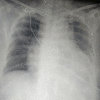Platinum sensitive carcinoma of ovary relapsed as pericardial effusion with cardiac tamponade
- PMID: 30904894
- PMCID: PMC6510153
- DOI: 10.1136/bcr-2018-228268
Platinum sensitive carcinoma of ovary relapsed as pericardial effusion with cardiac tamponade
Abstract
Epithelial ovarian cancers typically spread by intraperitoneal exfoliation and retroperitoneal lymph nodal involvement along the ovarian vascular supply. Pericardial involvement in ovarian malignancies is very rare with only few cases reported in the literature. Malignancy is the most common cause for pericardial effusion in the western world. In this case report, we present a 58-year-old woman treated for high-grade serous carcinoma of the ovary in 2010, relapsed with pericardial effusion and cardiac tamponade in 2017. Imaging studies revealed gross pericardial effusion. Two-dimensional echocardiogram showed massive pericardial effusion, with cardiac tamponade, New York Heart Association-IV. Pericardiocentesis and pigtail drain was placed under echo guidance. Immunocytochemistry has confirmed the tumour cells to be of the ovarian origin. The patient underwent surgical pericardial window via thoracotomy, followed by paclitaxel and carboplatin-based chemotherapy and olaparib maintenance.
Keywords: cancer - see oncology; chemotherapy; gynecological cancer.
© BMJ Publishing Group Limited 2019. No commercial re-use. See rights and permissions. Published by BMJ.
Conflict of interest statement
Competing interests: None declared.
Figures




Similar articles
-
Malignant pericardial effusion with cardiac tamponade in ovarian adenocarcinoma.Arch Gynecol Obstet. 2009 Oct;280(4):675-8. doi: 10.1007/s00404-009-0976-5. Epub 2009 Feb 19. Arch Gynecol Obstet. 2009. PMID: 19225795
-
Successful treatment of malignant pericardial effusion, using weekly paclitaxel, in a patient with breast cancer.Int J Clin Oncol. 2006 Oct;11(5):412-5. doi: 10.1007/s10147-006-0593-2. Int J Clin Oncol. 2006. PMID: 17058141
-
Malignant Pericardial Effusion in Ovarian Malignancy: A Treatable Oncologic Emergency.J Emerg Med. 2015 Sep;49(3):281-3. doi: 10.1016/j.jemermed.2015.04.024. Epub 2015 Jul 3. J Emerg Med. 2015. PMID: 26149806
-
Cardiac tamponade and severe pericardial effusion in systemic sclerosis: report of nine patients and review of the literature.Int J Rheum Dis. 2017 Oct;20(10):1582-1592. doi: 10.1111/1756-185X.12952. Epub 2016 Dec 10. Int J Rheum Dis. 2017. PMID: 27943614 Review.
-
Malignant pericardial effusion with cardiac tamponade in a patient with metastatic vaginal adenocarcinoma.Int J Gynecol Cancer. 2006 May-Jun;16(3):1458-61. doi: 10.1111/j.1525-1438.2006.00584.x. Int J Gynecol Cancer. 2006. PMID: 16803549 Review.
Cited by
-
Rare Distant Metastatic Disease of Ovarian and Peritoneal Carcinomatosis: A Review of the Literature.Cancers (Basel). 2019 Jul 24;11(8):1044. doi: 10.3390/cancers11081044. Cancers (Basel). 2019. PMID: 31344859 Free PMC article. Review.
-
Cytology positive pericardial effusion causing tamponade in patients with high grade serous carcinoma of the ovary.Gynecol Oncol Rep. 2020 Aug 7;33:100621. doi: 10.1016/j.gore.2020.100621. eCollection 2020 Aug. Gynecol Oncol Rep. 2020. PMID: 32904348 Free PMC article.
-
Malignant Müllerian Adenocarcinoma Manifesting With Cardiac Tamponade and Pleural Effusion.Cureus. 2021 Jul 7;13(7):e16233. doi: 10.7759/cureus.16233. eCollection 2021 Jul. Cureus. 2021. PMID: 34268062 Free PMC article.
-
Malignant Pericardial Tamponade Secondary to Ovarian Clear Cell Carcinoma.Yonago Acta Med. 2023 Oct 27;66(4):459-462. doi: 10.33160/yam.2023.11.004. eCollection 2023 Nov. Yonago Acta Med. 2023. PMID: 38028261 Free PMC article.
References
-
- Blich M, Malkin L, Kapeliovich M. Malignant pericardial tamponade secondary to papillary serous adenocarcinoma of the ovary. Isr Med Assoc J 2007;9:337–8. - PubMed
Publication types
MeSH terms
Substances
LinkOut - more resources
Full Text Sources
Medical
